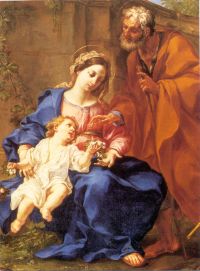Queen of Families
Mary, Queen of Families
– Reverend Matthew R. Mauriello
Our Holy Father, Pope John Paul II has inserted a new invocation, "Queen of Families," in the Litany of the Blessed Virgin. On December 31, 1995, the Sacred Congregation for Divine Worship sent a letter to the Episcopal conferences of the world informing of the Holy Father's addition to the litany. This new title is to be inserted in the litany after "Queen of the Most Holy Rosary" and before "Queen of Peace." This is the second time that Pope John Paul has added an invocation in the litany. In 1980, he inserted the title "Mother of the Church" into the ancient litany.

The Litany of the Blessed Virgin is also known as the Litany of Loreto. It owes its origin to the Greek Church whose litany-like Akathist Hymn was translated into Latin around the eighth century. It was used widely in Europe and records show that the litany was in use in Paris around the year 1200. The litany was also used at the Italian shrine of Loreto in the year 1558, and from there became widespread as a popular devotion. Pope Sixtus V approved its usage for the universal church in 1587.
In the last two centuries, seven titles have been added to this prayer. Besides the two additions of Pope John Paul II already mentioned, other five are: "Queen Conceived Without Original Sin" (Pius IX in 1854), "Queen of the Most Holy Rosary" (Leo XIII in 1883), "Mother of Good Counsel" (Leo XIII in 1903) , "Queen of Peace" (Benedict XV in 1916) and "Queen Assumed into Heaven" (Pius XII in 1950).
The invocation "Queen of Families" is a relatively new title and flows naturally from the fact that Mary is Mother of the Church. The family is considered the 'domestic church', since it is there that the seed of faith which is planted in the Sacrament of Baptism is nourished and flourished by the teaching and good example of the parents and members of the home. The family is the smallest cell of the church which builds up the Mystical Body of Christ. It is in the family that we find the first school of prayer and the moral and social virtues that form the basis for society. The family is the place which builds up the world by guarding and transmitting virtues and values from parent to child by what is taught and lived.
In 1964, during the proceedings of the Second Vatican Council, four hundred bishops petitioned the Holy See for the inclusion of this title in the litany. During the recent International Year of the Family, many bishops and lay organizations as well requested that an invocation be proposed which would speak of Mary's relation to the Holy Family of Nazareth. Mary called herself the 'Handmaid of the Lord' (Luke 1:38) and through her obedience to the Will of God she accepted her vocation as wife and mother in the family of Nazareth. She put herself in God's service and thereby put herself in the service of others.
In the Apostolic Exhortation, Familiaris Consortio, promulgated by the late Pope John Paul II on November 22, 1981, the Holy Father wrote," May the Virgin Mary, Mother of the Church, be also mother of the 'family church'. Through her maternal help, may every Christian family be a 'little church' in which the mystery of Christ is relived." We ask Mary, Queen of Families to bless, guide and protect each of our families. May she aid us to fight temptation and comfort us in our sorrows. May she help us on our pilgrim path to heaven there to enjoy her company to praise Jesus, her Son, for all eternity.
The above article appeared in the Fairfield County Catholic January 1996. Reprinted with permission of the author and publisher.
All About Mary includes a variety of content, much of which reflects the expertise, interpretations and opinions of the individual authors and not necessarily of the Marian Library or the University of Dayton. Please share feedback or suggestions with marianlibrary@udayton.edu.
